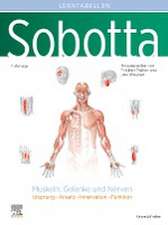The Development of the Larval Pigment Patterns in Triturus alpestris and Ambystoma mexicanum: Advances in Anatomy, Embryology and Cell Biology, cartea 118
Autor Hans-Henning Epperlein, Jan Löfbergen Limba Engleză Paperback – 5 apr 1990
Din seria Advances in Anatomy, Embryology and Cell Biology
- 5%
 Preț: 1146.33 lei
Preț: 1146.33 lei - 5%
 Preț: 721.19 lei
Preț: 721.19 lei - 15%
 Preț: 637.13 lei
Preț: 637.13 lei -
 Preț: 381.81 lei
Preț: 381.81 lei - 15%
 Preț: 644.95 lei
Preț: 644.95 lei - 5%
 Preț: 1025.16 lei
Preț: 1025.16 lei - 15%
 Preț: 689.97 lei
Preț: 689.97 lei - 15%
 Preț: 577.07 lei
Preț: 577.07 lei - 15%
 Preț: 580.36 lei
Preț: 580.36 lei - 5%
 Preț: 393.51 lei
Preț: 393.51 lei -
 Preț: 408.66 lei
Preț: 408.66 lei -
![Die Schlüpfdrüse der Geburtshelferkröte (Alytes o. obstetricans [LAURENTI]) und anderer Froschlurche](https://i4.books-express.ro/bs/9783662239742/die-schluepfdruese-der-geburtshelferkroete-alytes-o-obstetricans-laurenti-und-anderer-froschlurche.jpg) Preț: 408.27 lei
Preț: 408.27 lei - 5%
 Preț: 1090.61 lei
Preț: 1090.61 lei - 5%
 Preț: 705.11 lei
Preț: 705.11 lei - 5%
 Preț: 706.04 lei
Preț: 706.04 lei - 5%
 Preț: 357.61 lei
Preț: 357.61 lei - 5%
 Preț: 704.59 lei
Preț: 704.59 lei - 5%
 Preț: 705.11 lei
Preț: 705.11 lei - 5%
 Preț: 359.42 lei
Preț: 359.42 lei - 5%
 Preț: 711.52 lei
Preț: 711.52 lei - 15%
 Preț: 635.47 lei
Preț: 635.47 lei - 15%
 Preț: 631.72 lei
Preț: 631.72 lei - 15%
 Preț: 633.35 lei
Preț: 633.35 lei - 15%
 Preț: 632.37 lei
Preț: 632.37 lei - 5%
 Preț: 706.60 lei
Preț: 706.60 lei - 15%
 Preț: 631.07 lei
Preț: 631.07 lei - 5%
 Preț: 707.13 lei
Preț: 707.13 lei - 5%
 Preț: 707.33 lei
Preț: 707.33 lei - 5%
 Preț: 359.60 lei
Preț: 359.60 lei - 5%
 Preț: 707.69 lei
Preț: 707.69 lei - 5%
 Preț: 708.06 lei
Preț: 708.06 lei - 5%
 Preț: 706.41 lei
Preț: 706.41 lei - 5%
 Preț: 708.78 lei
Preț: 708.78 lei - 5%
 Preț: 705.68 lei
Preț: 705.68 lei - 5%
 Preț: 705.11 lei
Preț: 705.11 lei - 5%
 Preț: 706.77 lei
Preț: 706.77 lei - 15%
 Preț: 635.15 lei
Preț: 635.15 lei - 15%
 Preț: 631.07 lei
Preț: 631.07 lei - 5%
 Preț: 706.77 lei
Preț: 706.77 lei - 5%
 Preț: 706.04 lei
Preț: 706.04 lei - 5%
 Preț: 710.79 lei
Preț: 710.79 lei - 5%
 Preț: 705.32 lei
Preț: 705.32 lei - 15%
 Preț: 633.19 lei
Preț: 633.19 lei - 15%
 Preț: 629.09 lei
Preț: 629.09 lei - 15%
 Preț: 633.53 lei
Preț: 633.53 lei - 15%
 Preț: 632.70 lei
Preț: 632.70 lei - 15%
 Preț: 633.68 lei
Preț: 633.68 lei - 18%
 Preț: 773.72 lei
Preț: 773.72 lei - 15%
 Preț: 630.43 lei
Preț: 630.43 lei
Preț: 707.13 lei
Preț vechi: 744.35 lei
-5% Nou
Puncte Express: 1061
Preț estimativ în valută:
135.31€ • 141.27$ • 111.99£
135.31€ • 141.27$ • 111.99£
Carte tipărită la comandă
Livrare economică 04-18 aprilie
Preluare comenzi: 021 569.72.76
Specificații
ISBN-13: 9783540516729
ISBN-10: 3540516727
Pagini: 120
Ilustrații: XI, 101 p. 38 illus.
Dimensiuni: 170 x 242 x 6 mm
Greutate: 0.2 kg
Ediția:1989
Editura: Springer Berlin, Heidelberg
Colecția Springer
Seria Advances in Anatomy, Embryology and Cell Biology
Locul publicării:Berlin, Heidelberg, Germany
ISBN-10: 3540516727
Pagini: 120
Ilustrații: XI, 101 p. 38 illus.
Dimensiuni: 170 x 242 x 6 mm
Greutate: 0.2 kg
Ediția:1989
Editura: Springer Berlin, Heidelberg
Colecția Springer
Seria Advances in Anatomy, Embryology and Cell Biology
Locul publicării:Berlin, Heidelberg, Germany
Public țintă
ResearchCuprins
1 Introduction.- 2 Materials and Methods.- 2.1 Embryos.- 2.2 Light Microscopy.- 2.3 Videomicrography.- 2.4 Transmission Electron Microscopy.- 2.5 Scanning Electron Microscopy.- 2.6 Dopa Reaction.- 2.7 Pterin Fluorescence.- 2.8 Staining with Alcian Blue.- 2.9 Immunohistochemistry.- 2.10 Developmental Protocols.- 2.11 Embryological Experiments.- 2.12 Tissue Culture.- 3 Results.- 3.1 Fundamental Premises.- 3.2 Development of the Longitudinal Stripe Pattern in Triturus alpestris.- 3.3 Development of the Barred Pigment Pattern in Ambystoma mexicanum.- 3.4 Analysis of Factors and Mechanisms Governing Pigment Pattern Formation in Triturus alpestris.- 3.5 Analysis of Factors and Mechanisms Governing Pigment Pattern Formation in Ambystoma mexicanum.- 4 Discussion.- 4.1 Dopa Reaction and Pterin Fluorescence: Criticism of the Methods.- 4.2 Organization of the Neural Crest and Early Dispersion of Pigment Cells.- 4.3 Arrangement of Pigment Cells in the Trunk.- 4.4 Comparison of the Development of the Larval Pigment Pattern in Triturus alpestris and Ambystoma mexicanum.- 4.5 Conclusion and Perspectives.- 5 Summary.- Acknowledgements.- References.










